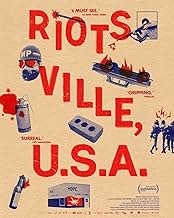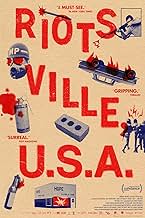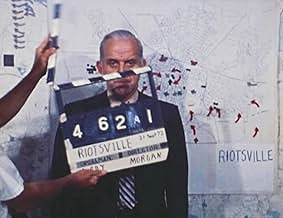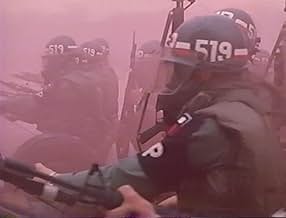अपनी भाषा में प्लॉट जोड़ेंWelcome to Riotsville, a fictional town built by the US military. Using all archival footage, the film explores the militarization of the police and creates a counter-narrative to the nation... सभी पढ़ेंWelcome to Riotsville, a fictional town built by the US military. Using all archival footage, the film explores the militarization of the police and creates a counter-narrative to the nation's reaction to the uprisings of the late '60s.Welcome to Riotsville, a fictional town built by the US military. Using all archival footage, the film explores the militarization of the police and creates a counter-narrative to the nation's reaction to the uprisings of the late '60s.
- पुरस्कार
- 4 जीत और कुल 10 नामांकन
Lyndon B. Johnson
- Self
- (आर्काइव फ़ूटेज)
Otto Kerner
- Self - Chairman
- (आर्काइव फ़ूटेज)
- (as Governor Otto Kerner)
Edward P. Morgan
- Self - PBL Chief Correspondent
- (आर्काइव फ़ूटेज)
Robert Curvin
- Self - Former Chairman, Neward CORE
- (आर्काइव फ़ूटेज)
Leonard Kowalewski
- Self - Newark Police
- (आर्काइव फ़ूटेज)
John Harrington
- Self - Fraternal Order of Police
- (आर्काइव फ़ूटेज)
- (as Sgt. John Harrington)
Albert Cleage
- Self
- (आर्काइव फ़ूटेज)
- (as The Rev. Albert Cleage)
Alvin F. Poussaint
- Self - Tufts University
- (आर्काइव फ़ूटेज)
- (as Dr. Albert Poussaint)
Fred Harris
- Self - Commission Member
- (आर्काइव फ़ूटेज)
- (as Sen. Fred R Harris)
Dick Gregory
- Self
- (आर्काइव फ़ूटेज)
Roger Mudd
- Self
- (आर्काइव फ़ूटेज)
Robert Byrd
- Self
- (आर्काइव ध्वनि)
- (as Senator Robert Byrd)
Jimmy Collier
- Self
- (आर्काइव फ़ूटेज)
Frederick Douglass Kirkpatrick
- Self
- (आर्काइव फ़ूटेज)
- (as Rev. Frederick Douglass Kirkpatrick)
Ronald Reagan
- Self
- (आर्काइव फ़ूटेज)
Spiro Agnew
- Self
- (आर्काइव फ़ूटेज)
- (as Gov. Spiro Agnew)
Strom Thurmond
- Self
- (आर्काइव फ़ूटेज)
- (as Sen. Strom Thurmond)
फ़ीचर्ड समीक्षाएं
Greetings again from the darkness. A couple of old sayings came to mind while watching this. "The more things change, the more they stay the same." This ties together what we see from the 1960's with what we've seen very recently in the U. S. Next would be, "You made your bed, now sleep in it." This references the manner in which our government reacted to civil unrest in the 1960s has affected our society for the past 50+ years.
Documentarian Sierra Pettingill utilizes only archival footage from TV (newscasts and talk shows) and military footage filmed during the era. The clips are edited in a way to tell the story of how the government responded to increased civil unrest, and how those responses not only made the situation worse, it also set the table for ongoing societal issues for decades to come.
Historical background includes President Lyndon Johnson forming the Kerner Commission (officially The National Advisory Commission on Civil Disorders), and how the resulting 700 page 1968 report did not provide the conclusions expected by the government. It warned of two societies - one white, one black, separate and unequal. The corresponding action items were deemed too expensive due to the ongoing Vietnam War. Instead an addendum suggested expanded federal funding for police ... that one hit home with politicians.
Much of the footage, as well as the film's title, comes from the model town constructed by the military at Fort Belvoir in Virginia. It's here where training sessions occurred with military personnel cast as rioters and law enforcement learned the approaches to quell the uprising. Unfortunately, most of these approaches involved law enforcement escalation during civil unrest, leaving us wondering which causes the most damage. We even see military leaders observing the drills from the grandstands, applauding and laughing in some parts. It's impossible not to notice that these are all white faces.
Further escalation and federal funding resulted in specialty tanks, and we see the training videos around this weapon. At its core, what we see is a simulated riot in a simulated city. It's easy to view this as training hate and power, rather than learning de-escalation techniques. Director Pettingill also includes clips from PBL (precursor to PBS) talk shows like "Civil Disorder". These shows, and their debates, caused Ford Motor Company to withdraw funding in 1969. The news clips from the 1968 Democrat and Republican conventions provide some insight into the reporting during this era. Especially biting is David Brinkley's response to Strom Thurmond's comments. The film's only weakness comes in the form of narration from Charlene Modeste. The words are simply too flowery or artsy for such subject matter. This is a film that urges you to feel the frustrations. It turns out "Law & Order" can be twisted by those in power.
Releasing in theaters and OnDemand beginning September 16, 2022.
Documentarian Sierra Pettingill utilizes only archival footage from TV (newscasts and talk shows) and military footage filmed during the era. The clips are edited in a way to tell the story of how the government responded to increased civil unrest, and how those responses not only made the situation worse, it also set the table for ongoing societal issues for decades to come.
Historical background includes President Lyndon Johnson forming the Kerner Commission (officially The National Advisory Commission on Civil Disorders), and how the resulting 700 page 1968 report did not provide the conclusions expected by the government. It warned of two societies - one white, one black, separate and unequal. The corresponding action items were deemed too expensive due to the ongoing Vietnam War. Instead an addendum suggested expanded federal funding for police ... that one hit home with politicians.
Much of the footage, as well as the film's title, comes from the model town constructed by the military at Fort Belvoir in Virginia. It's here where training sessions occurred with military personnel cast as rioters and law enforcement learned the approaches to quell the uprising. Unfortunately, most of these approaches involved law enforcement escalation during civil unrest, leaving us wondering which causes the most damage. We even see military leaders observing the drills from the grandstands, applauding and laughing in some parts. It's impossible not to notice that these are all white faces.
Further escalation and federal funding resulted in specialty tanks, and we see the training videos around this weapon. At its core, what we see is a simulated riot in a simulated city. It's easy to view this as training hate and power, rather than learning de-escalation techniques. Director Pettingill also includes clips from PBL (precursor to PBS) talk shows like "Civil Disorder". These shows, and their debates, caused Ford Motor Company to withdraw funding in 1969. The news clips from the 1968 Democrat and Republican conventions provide some insight into the reporting during this era. Especially biting is David Brinkley's response to Strom Thurmond's comments. The film's only weakness comes in the form of narration from Charlene Modeste. The words are simply too flowery or artsy for such subject matter. This is a film that urges you to feel the frustrations. It turns out "Law & Order" can be twisted by those in power.
Releasing in theaters and OnDemand beginning September 16, 2022.
But this was far below what i expected from a historical perspective. Its the black and white stigmata over and over again, and what really should be delved with, namely how antiriot enforcement where thought to be and how it came to be in the name of riotsville usa drowns in a claustrophobic, cataclysmic psychedelic epileptic triggering lightshows and overfocused still, and a neoneoneoultra composed musical scored( like norwegian composer arne nordheim) makes this a complete rotten mess historywise. Its narrative voice never tells how much was spended or how large this antiriotforce buildup was, and the real riots that couldve made this documentary a real document of history lacks completely.
So if this is how riots have been handled over the years then its time to look somewhere else. As a filmproduct it lacks quality on most bases, and the amount of positive criticism over a ribbed and untelling way to tell a story that has been told here really feels fictitious. The grumpy old man doesnt recommend this one, and will cry out a call to the big documentarymakers to make a series about the real rioting 60's and the real face of the crammed crow.
So if this is how riots have been handled over the years then its time to look somewhere else. As a filmproduct it lacks quality on most bases, and the amount of positive criticism over a ribbed and untelling way to tell a story that has been told here really feels fictitious. The grumpy old man doesnt recommend this one, and will cry out a call to the big documentarymakers to make a series about the real rioting 60's and the real face of the crammed crow.
Violent police repression as a first response tactic against protests, still seems to dominate todays American society as much as it did during the sixties.
This eyeopening documentary gives us a surprisingly detailed insight into how authorities reacted to the first mass race riots and civil rights protests during the sixties.
This documentary has got lots of interesting LIVE public television footage about racism and inequality and police brutality and it uses a police training video for how to handle riots as a red line through this entire movie about how the goverment responded to civil rights protests and race riots during the sixties.
In general the government did 2 things to "respond" to the protests and race riots:
1.
The authorities investigated the cause of race riots during the sixties by appointing a commision of conservatives who came to a similar conclusion as the African American people who were protesting, namely that American society was brutally split and full of inequality and racism.
2.
Shocked by this unwelcome outcome of the conservative comission the government only accepted one tiny subconclusion out of the entire comission's report and that was to give the police more weapons to repress riots...
This documentaries' strength lies in the abstract narration and style. Because of that style the total oblivion of goverment officials becomes even more painfully clear for all to see...
I have seen several documentaries about racism and police brutality lately and this is the one that got me thinking the most about the world of total oblivion that politicians are wallowing in...
This eyeopening documentary gives us a surprisingly detailed insight into how authorities reacted to the first mass race riots and civil rights protests during the sixties.
This documentary has got lots of interesting LIVE public television footage about racism and inequality and police brutality and it uses a police training video for how to handle riots as a red line through this entire movie about how the goverment responded to civil rights protests and race riots during the sixties.
In general the government did 2 things to "respond" to the protests and race riots:
1.
The authorities investigated the cause of race riots during the sixties by appointing a commision of conservatives who came to a similar conclusion as the African American people who were protesting, namely that American society was brutally split and full of inequality and racism.
2.
Shocked by this unwelcome outcome of the conservative comission the government only accepted one tiny subconclusion out of the entire comission's report and that was to give the police more weapons to repress riots...
This documentaries' strength lies in the abstract narration and style. Because of that style the total oblivion of goverment officials becomes even more painfully clear for all to see...
I have seen several documentaries about racism and police brutality lately and this is the one that got me thinking the most about the world of total oblivion that politicians are wallowing in...
The trailer for this movie focused on the fake towns - they look like movie sets - that were built in the 1960s so that the Army could practice dealing with "race riots."
As it turns out in the movie, there were only two such Riotsvilles, and they play only a very small roll in this movie. That's very unfortunate, imo. I would have liked to know how they were financed - did Congress know about them? - how the soldiers were chosen to stage crowd control in them, etc. In other words, I would have appreciated it if the movie had concentrated on the riotsvilles.
Instead, most of the movie deals with the Civil Rights Movement and white reaction to it in the 1960s. That's interesting, of course, but nothing new. Sometimes it really seemed like filler for a movie that should have been a short rather than a feature-length film.
The narration got a little shrill at times for my tastes. The images and newsreel footage that are the basis of this movie are already powerful, and speak for themselves Since no one opposed to the Civil Rights Movement is going to watch this movie, there's no point in preaching to the already converted.
An ok movie, in short, but not enough new material to warrant its 91 minute run time.
As it turns out in the movie, there were only two such Riotsvilles, and they play only a very small roll in this movie. That's very unfortunate, imo. I would have liked to know how they were financed - did Congress know about them? - how the soldiers were chosen to stage crowd control in them, etc. In other words, I would have appreciated it if the movie had concentrated on the riotsvilles.
Instead, most of the movie deals with the Civil Rights Movement and white reaction to it in the 1960s. That's interesting, of course, but nothing new. Sometimes it really seemed like filler for a movie that should have been a short rather than a feature-length film.
The narration got a little shrill at times for my tastes. The images and newsreel footage that are the basis of this movie are already powerful, and speak for themselves Since no one opposed to the Civil Rights Movement is going to watch this movie, there's no point in preaching to the already converted.
An ok movie, in short, but not enough new material to warrant its 91 minute run time.
Originally premiered at the 2022 Sundance Film Festival in the NEXT selection.
Director Sierra Pettengill makes a documentary about a fictional town named Riotsville which was built by the US military and explores the militarization of the police and creates a counter-narrative to the nation's reaction to the uprisings of the late '60s. The issues of police and riots are still a very common theme in the modern days. This documentary may be considered relevant in todays time because of all the political things happening at this very moment.
The music choice to create an uneven tension really helps to make you feel uneasy of what you are learning, the narration from Charlene Modeste does really help to add an feeling of uneasiness while you are witnessing archival footage of riots and insane things happening. There are some really good conversations from political members, citizens, news people, and others that are presented in this documentary to capture a realistic point of view.
However, the editing becomes really sloppy and some of the technical moments are noticeably bad. As if there are some errors during post-production when making this movie. Overall, a good documentary.
Rating: B.
Director Sierra Pettengill makes a documentary about a fictional town named Riotsville which was built by the US military and explores the militarization of the police and creates a counter-narrative to the nation's reaction to the uprisings of the late '60s. The issues of police and riots are still a very common theme in the modern days. This documentary may be considered relevant in todays time because of all the political things happening at this very moment.
The music choice to create an uneven tension really helps to make you feel uneasy of what you are learning, the narration from Charlene Modeste does really help to add an feeling of uneasiness while you are witnessing archival footage of riots and insane things happening. There are some really good conversations from political members, citizens, news people, and others that are presented in this documentary to capture a realistic point of view.
However, the editing becomes really sloppy and some of the technical moments are noticeably bad. As if there are some errors during post-production when making this movie. Overall, a good documentary.
Rating: B.
टॉप पसंद
रेटिंग देने के लिए साइन-इन करें और वैयक्तिकृत सुझावों के लिए वॉचलिस्ट करें
- How long is Riotsville, U.S.A.?Alexa द्वारा संचालित
विवरण
बॉक्स ऑफ़िस
- US और कनाडा में सकल
- $40,960
- US और कनाडा में पहले सप्ताह में कुल कमाई
- $5,597
- 18 सित॰ 2022
- दुनिया भर में सकल
- $44,392
- चलने की अवधि1 घंटा 31 मिनट
- रंग
इस पेज में योगदान दें
किसी बदलाव का सुझाव दें या अनुपलब्ध कॉन्टेंट जोड़ें

























